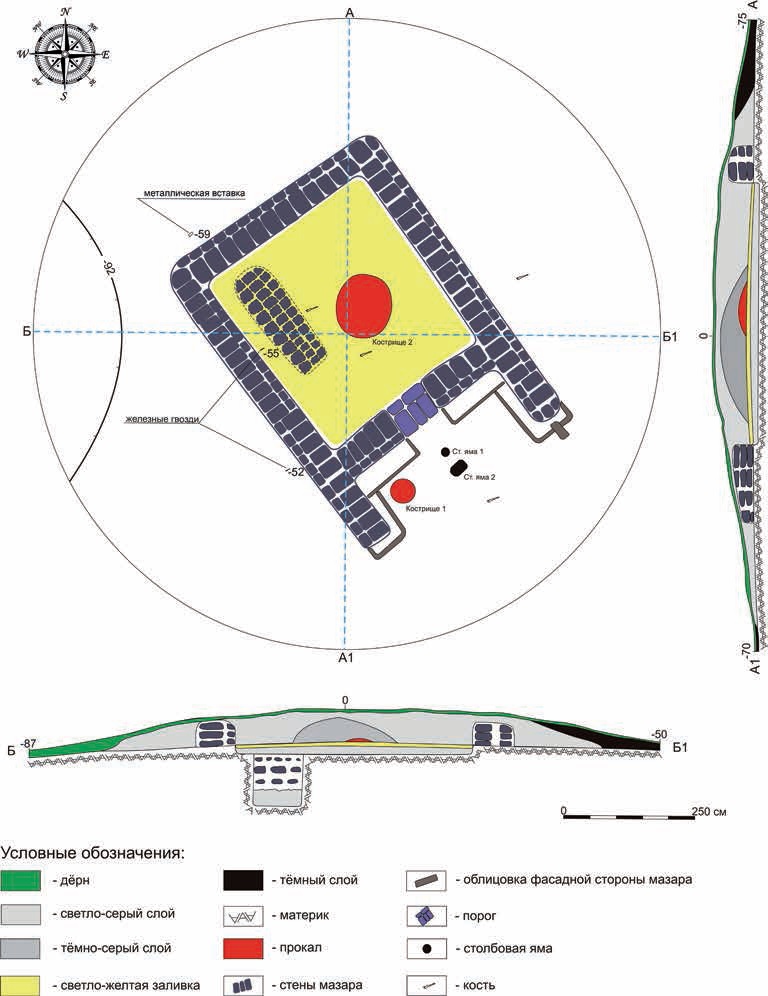CENOTAPH OF THE GOLDEN HORDE TIME AT THE TOMBSTONE OF KOTYRTAS (Central Kazakhstan)
DOI:
https://doi.org/10.52967/akz2019.4.6.19.31Keywords:
archaeology, Central Kazakhstan, the Middle Ages, the Golden Horde time, raw fence, sagan, cenotaph, IslamizationAbstract
The small number of the XII–XV centuries monuments studied on the territory of Central Kazakhstan, the introduction of any new materials into the scientific circulation is being updated. In the framework of this article, the authors highlight the results of the studies of the Golden Horde mound at the Kotyrtas burial ground (Shet district of the Karagandy region), which contained an adobe brick fence with an annex in the form of a “peshtak portal” under the earthen mound. Noteworthy are the traces of two fireplaces, pillar pits, the entrance chamber with a masonry threshold, the facade side of the building and the coating of the inner-city space with a thin layer of clay. The burial chamber was laid in the upper part with raw bricks and resembles a sagan (brick tombstone of Muslim graves), the masonry of which rested on a wooden floor. No burial was detected, which allows determining the object as a cenotaph. Some criticisms have been made to the well-known chronology of raw fences, based on the presence or absence of a number of structural elements. In the conclusions, the authors come to the need to date the investigated structure of the Kotyrtas burial ground in the XIII–XIV centuries.
References
Akishev, K. A., Khasenova, B. M., Motov, Yu. A. 2008. In Bozok v panorama srednevekovyh kultur Evrazii (Bozok in the panorama of medieval cultures of Eurasia). Astana: L.N. Gumilev Eurasian National University, 56-65 (in Russian).
In: URL: https://kazpravda.kz/articles/view/artefakti-zolotoi-ordi
Botalov S.G. 1992. In Rossiyskaya arheologiya (Russian archeology), 2, 230-239 (in Russian).
Varfolomeev, V. V., Kukushkin, I. A., Dmitriev, E. A. 2017. In Istoriya i arheologiya Semirechiya (History and archeology of Semirechye), 5. Almaty: A.Kh. Margulan Institute of Archaeology, 167-173 (in Russian).
Vasiliev, D. V. 2006. In Voprosy istorii i arheologii Zapadnogo Kazahstana (Questions of history and archeology of Western Kazakhstan), 1–2, 208-220 (in Russian).
Kadyrbyaev, M. K., Burnasheva, R. Z. 1970. In Po sledam drevnih kultur Kazahstana (Following the tracks of ancient cultures of Kazakhstan). Alma-Ata: “Nauka” Publ., 42-53 (in Russian).
Kriger, V. A., Maryksin, D. V. 2008. In Voprosy istorii i arheologii Zapadnogo Kazahstana (Questions of history and archeology of Western Kazakhstan), 1, 193-206 (in Russian).
Kukushkin, I. A., Dmitriev, E. A., Kukushkin, A. I. 2019. In Bazarov, B. V., Kradin, N. N. (Eds.) Kochevye imperii Evrazii v svete arheologicheskih i mezhdisciplinarnyh issledovanij (The nomadic empires of Eurasia in the light of archaeological and interdisciplinary research), 1. Ulan-Ude: BNC SO RAN, 135-137 (in Russian).
Loman, V. G., Dmitriev, E. A., Kukushkin, I. A., Kukushkin, A. I. 2017. In Beisenov, A. Z., Loman, V. G. (Eds.) Arheologicheskoe nasledie Centralnogo Kazahstana: izuchenie i sohranenie (Archaeological Heritage of Central Kazakhstan: Study and Preservation). Almaty: “Begazy-Tasmola” Publ., 209-218 (in Russian).
Margulan, A. Kh. 1959. In Trudy Instituta istorii, arheologii i etnografii Akademii nauk Kazahskoj SSR (Proceedings of the Institute of History, Archeology and Ethnography of the Academy of Sciences of the Kazakh SSR), 7, 248-261 (in Russian).
Maryksin, D. V. 2012. In Voprosy istorii i arheologii Zapadnogo Kazahstana (Questions of history and archeology of Western Kazakhstan), 1, 111-119 (in Russian).
Myskov, E. P. 2003. In Nizhnevolzhskij arheologicheskij vestnik (Lower Volga Archaeological Bulletin), 6, 216-235 (in Russian).
Rakushin, A. I. 1993. In Arheologicheskie vesti (Archaeological News), 1. Saratov: Saratov State University Publ., 170-175 (in Russian).
Rykov, P. S. 1935. In Arheologicheskie raboty Akademii na novostrojkah v 1932-1933 gg. (The archaeological work of the Academy in new buildings in 1932–1933.), 109–110, II. Moscow-Leningrad: OGIZ State Socio-Economic Publishing House, 40-68 (in Russian).
Usmanova, E. R. 1987. In Rannij zheleznyj vek i srednevekovie Uralo-Irtyshskogo mezhdurechiya (Early Iron Age and Middle Ages of the Ural-Irtysh interfluve.). Chelyabinsk: “Bashkir University” Publ., 99-105 (in Russian).
Usmanova, E. R., Dremov, I. I., Panyushkina, I. P., Kolbina, A. V. 2018. In Arheologiya, etnografiya i antropologiya Evrazii (Archeology, Ethnography and Anthropology of Eurasia.), 46, 2, 106-113 (in Russian).
Fedorov-Davydov, G. A. 1966. Kochevniki Vostochnoj Evropy pod vlastiyu zolotoordynskih hanov. Arheologicheskie pamyatniki (Nomads of Eastern Europe under the rule of the Golden Horde khans. Archaeological sites). Moscow: “Moskow University” Publ. (in Russian).
Khabdulina, M. K. 2016. Materialy Kongressa islamskoj arheologii Rossii i stran SNG (Materials of the Congress of Islamic Archeology of Russia and the CIS). Kazan: Institute of Archaeology named after A.Kh. Khalikov, 250-261 (in Russian).

Downloads
Published
How to Cite
Issue
Section
License
Copyright (c) 2019 A.I. Kukushkin, E.A. Dmitriev, I.A. Kukushkin

This work is licensed under a Creative Commons Attribution-NonCommercial 4.0 International License.






